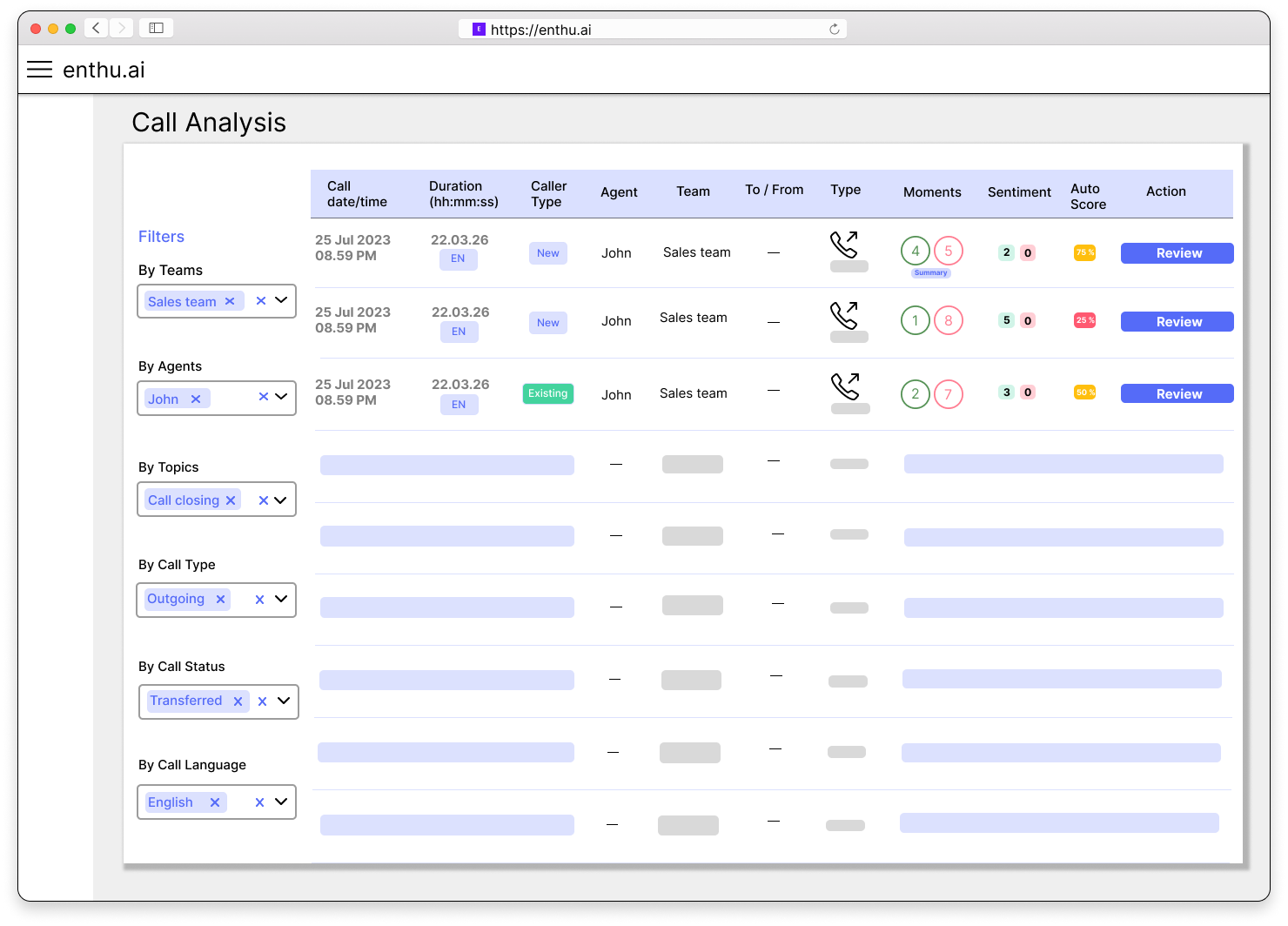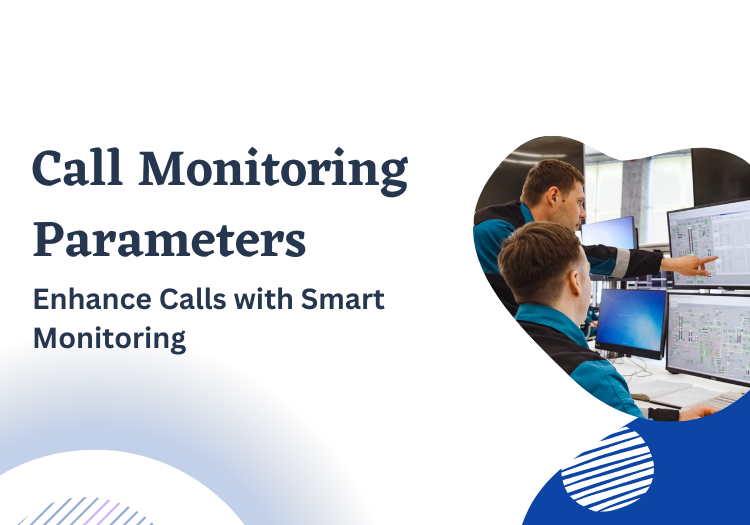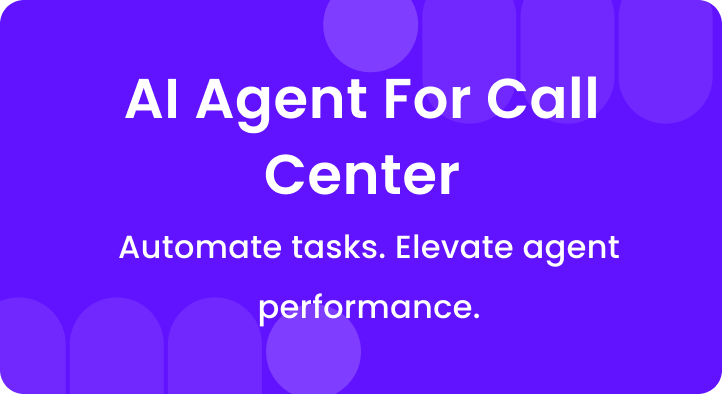Want to provide exceptional support, improve customer experience, and boost brand reputation?
If yes, it’s crucial to understand how effectively your customer service representatives handle conversations with customers.
Measuring your call center agents’ performances and tracking the call quality allows you to assess the effectiveness of your customer service operations, identify weaknesses, and optimize processes.
Today, 89% of consumers are more likely to make another purchase after a positive customer service experience.
And call centers that focus on using different call monitoring parameters will find it easier to satisfy customers, identify areas of improvement, and provide training & coaching to your employees.
These parameters provide valuable insights into the type of agent-customer conversations that are successful for your business growth.
When it comes to call monitoring for quality and coaching, there are many metrics to consider.
Choosing parameters that are clear, easy to understand, and aligned with your business needs is essential.
Explore some key call monitoring parameters to help you focus on what matters most for your call center business.
A. What are call monitoring parameters?
Call monitoring parameters include metrics like call quality, agent performance, customer satisfaction, adherence to scripts, response time, tone, resolution accuracy, compliance, handling time, and overall effectiveness of the interaction.
These parameters help you assess how well your agents handle calls, ensuring they meet your company’s standards.
By tracking things like tone, adherence to scripts, resolution time, and customer satisfaction, you can identify areas where your team excels and where they might need improvement.
Understanding these metrics allows you to provide better coaching, enhance customer experience, and ultimately boost your call center’s overall performance.

B. 101 Call Monitoring Parameters for Quality and Coaching
We’ve categorized these metrics to help you quickly find the information that best fits your business needs.
Feel free to select the ones that work for you, and let us know in the comments if you have any additional metrics to suggest!
1. Greeting the customer
- Start with a warm greeting.
- Introduce yourself by name and job title.
- Mention your company.
- Thank the customer for their call.
- Inform them the call is being recorded.
- Ask for the customer’s name.
- Offer assistance by asking how you can help.
- For outbound calls, clearly state the purpose.
- Confirm you’re speaking with the account holder.
2. Phone Etiquette
- Use polite language and a friendly tone.
- Adjust your tone to match the customer’s mood.
- Ask how the customer prefers to be addressed.
- Always use the customer’s preferred name.
- Avoid interrupting the customer.
- Respond to questions promptly.
- Speak slowly and clearly.
- Listen carefully to the customer.
- Show empathy for their situation.
- Reassure them if they seem concerned or frustrated.
- Always ask before transferring their call.
- Ensure the customer is okay with being put on hold.
- Resolve their query before ending the call.
- Keep a positive and upbeat tone whenever possible.
3. Mistakes to avoid
- Never use abusive language or swear words.
- Avoid sarcasm or unpleasant tones.
- Don’t provide dishonest information.
- Never be rude to customers.
- Don’t raise your voice.
- Never hang up on a customer who is still speaking.
4. Script Adherence
- Follow the script provided.
- Adapt the script as needed while using appropriate language.
- Sound natural, even when following a script.
5. Account Verification
- Always ask for account verification.
- Use all necessary information to verify the account.
- Follow proper procedures if the account cannot be verified.
6. Collecting Customer Information
- Politely ask for the customer’s first and last name.
- Confirm spelling by repeating it back.
- Request their phone number in case of disconnection.
- Verify the phone number by repeating it.
- Ask for their email address.
- Confirm the email address by repeating it back.
- Ask how they heard about your business or who referred them.
7. Compliance
- Follow all procedures if a customer requests not to be contacted again.
- Handle cancellation requests appropriately.
- Use accurate descriptions when referring to products or services.
- Provide truthful answers to customer questions.
- Adhere to company guidelines for hold times.
- Use proper procedures for call transfers.
- Follow company protocols if a call needs escalation.
- Comply with national and state recording laws.
- Always quote prices within company guidelines.
8. Troubleshooting
- Take ownership of the problem as a representative of the company.
- Transfer the call to senior staff if needed.
- Show empathy for customer frustration.
- Apologize for any inconvenience caused.
- Manage expectations clearly and confidently.
- Identify the problem efficiently. 58. Ask for any relevant error codes.
- Summarize the issue to confirm understanding.
- Confirm the customer is satisfied with your understanding of their issue.
- Provide estimated timescales for resolving the issue.
- If necessary, ask about warranties or guarantees.
- Share helpful information for self-troubleshooting.
- Give the customer a reference number for their issue.
- Follow up with the customer, providing the reference number again.
9. Sales Calls
- Understand the customer’s needs for a product or service.
- Use a friendly tone to build rapport.
- Suggest products that match the customer’s needs.
- Aim to cross-sell or upsell when appropriate.
- Highlight the next steps clearly.
- Ensure the customer understands the value of the product or service.
- Take time to answer all questions.
- Encourage involving other decision-makers.
- Address any objections the customer may have.
- Know your products and services well to provide guidance.
- Always provide up-to-date pricing.
- Inform customers of any special offers.
- Reconfirm product/service details and pricing before taking payment.
- Schedule deadlines for service setup or product delivery.
- Collect billing information accurately. 81. Confirm if the delivery address differs from the billing address.
- Take payment at the customer’s pace.
- Schedule a follow-up call to gather feedback.
- Suggest changes to retain customers looking to cancel.
10. Ending the Call
- Follow any scripts for closing the call.
- Confirm the next steps with the customer.
- Make sure the customer is happy with the proposed actions.
- Confirm any appointments or deadlines.
- Ask if there’s anything else you can help with.
- Request feedback post-call.
- Thank the customer for calling.
- Wish them a good day or evening.
- Let them know they can call back if needed.
- Wait for the customer to hang up before ending the call.
11. After the Call
- Accurately log all information in the system.
- Document any issues or complaints.
- Alert senior staff about serious issues.
- Record any product-related problems.
- Follow up with the customer if promised.
- Set the correct call disposition.
- Make sure all post-call actions comply with company policies.
C. What are the benefits of tracking quality call monitoring parameters?
Here are some key benefits of tracking quality call monitoring parameters:
1. Improved customer satisfaction
Tracking call monitoring parameters helps ensure that agents consistently provide high-quality service to customers.
By closely monitoring these interactions, you can identify what positively impacts customer experiences and address any pain points.
When customers feel understood and valued, they are more likely to be satisfied with the service they receive.
Satisfied customers are not only more likely to return for future purchases but also tend to recommend your business to others, enhancing your brand’s reputation and fostering customer loyalty.

2. Enhanced agent performance
By analyzing call monitoring data, you can evaluate your agents’ performance based on key criteria such as communication skills, problem-solving abilities, and adherence to protocols.
This allows you to identify strengths and areas needing improvement for each agent.
With targeted feedback and coaching, agents can refine their skills and improve their overall performance.
As agents become more proficient, they handle customer interactions more effectively, leading to increased productivity, better service quality, and a more motivated and engaged workforce.

3. Increased operational efficiency
Tracking call monitoring parameters enables you to identify inefficiencies and bottlenecks within your call center processes.
By understanding what aspects of your operations are causing delays or customer dissatisfaction, you can make informed decisions to streamline workflows and reduce handling times.
This optimization leads to a more efficient use of resources, allowing agents to handle more calls effectively.
Increased operational efficiency reduces costs and ensures faster resolutions and a better overall customer experience, which can enhance your call center’s reputation.

4. Compliance and risk management
Monitoring parameters such as script adherence, customer data handling, and compliance with industry regulations helps ensure your call center operates within legal and ethical boundaries.
Regularly tracking these aspects allows you to identify deviations from company policies or regulatory requirements, allowing for quick corrective actions.
This proactive approach reduces the risk of non-compliance, which could otherwise lead to legal issues, fines, or damage to your company’s reputation.
Ensuring compliance also builds customer trust, as they feel assured that their interactions and data are handled properly.
D. Improve Call Quality and Agent Performance with Enthu.AI
With the right technology in place, you can track call quality and measure agent performance in your call center.
One such AI-powered solution in Enthu.AI.
Enthu.AI is a cutting-edge conversation intelligence and sales agent coaching software that helps you evaluate key agent performance metrics and provide top-notch customer experience.
The software offers a variety of advanced features such as call recording, call transcription, call monitoring, agent coaching and training, speech analytics, and more.
Enthu.AI provides quality assurance software that empowers your customer service agents to perform at their best while ensuring they receive the support they need to excel.
Additionally, its sales coaching and training features are designed to enhance your agents’ skills, equipping them with the tools and knowledge necessary to improve their performance and achieve success.
With Enthu.AI, everything you need is just a click away—one unified source of truth, all in one place! Experience it for yourself by requesting a free demo today.
Conclusion
Tracking call monitoring parameters is crucial for optimizing your call center’s performance and enhancing customer satisfaction.
By focusing on key metrics, you can improve the quality of interactions, boost agent performance, streamline operations, and ensure compliance with regulations.
This comprehensive approach helps you address issues and identify areas for improvement, fosters a positive customer experience, and builds a stronger brand reputation.
Implementing these parameters effectively will help you create a more efficient, customer-focused call center that drives success and growth.
FAQs
1. What are the parameters measured in a call?
Parameters measured in a call include tone, script adherence, resolution time, and customer satisfaction. These metrics help assess how well the call was handled and the quality of the interaction.
2. What are the parameters of monitoring?
Monitoring parameters include greeting etiquette, phone manners, script compliance, and problem-solving effectiveness. These parameters ensure that agents meet quality standards and provide excellent customer service.
3. What are the 5 quality parameters?
The five quality parameters are call greeting, phone etiquette, script adherence, issue resolution, and overall customer satisfaction. These factors help measure the effectiveness and professionalism of each call.




 On this page
On this page


